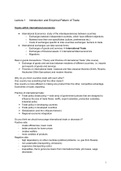Lecture 1 Introduction and Empirical Pattern of Trade
Topics within international economics
● International Economics: study of the interdependencies between countries
○ Exchanges between independent countries, which have different objectives
○ Markets have their own specificities (culture, preferences etc.)
○ Costs of exchanges specific to inter-countries exchanges: barriers to trade
● International exchanges can take several forms:
○ Exchanges of goods and services ⇒ International Trade
○ Exchanges of financial assets ⇒ International Macroeconomics
○ Migrations
Real or goods transactions: “Theory and Practice of International Trade” (this course)
➢ Exchange of goods and services between residents of different countries, i.e. imports
and exports of goods and services
➢ Theories on international trade: Classical and Neo-classical theories (Smith, Ricardo,
Heckscher-Ohlin-Samuelson) and modern theories
Why do you think countries trade with each other?
One country has something that the other doesn’t.
One country is more efficient in making one product than the other, competitive advantage.
Economies of scale, exporting.
Practice of international trade:
➢ Trade policy (trade policy = wide array of government policies that are designed to
influence the size of trade flows): tariffs, export subsidies, production subsidies,
industrial policy
➢ Trade policy in developing countries
➢ Trade policy in developed countries
➢ Globalization (and the critiques thereon)
➢ Regional economic integration
Do you think we should encourage international trade or decrease it?
Positive side:
- create efficiencies, lower costs
- better products for lower prices
- creates welfare
- more varieties of products
Negative side:
- high dependency on other countries (political problems, i.e. gas from Russia)
- not sustainable (transporting, emissions)
- expensive (transporting costs)
- inequalities, the’re gonna be losers from international trade; job losses, wage
decreases
1
,Empirical Patterns of Trade
Evolution of international trade over time
● Globalization is not a new phenomenon:
➢ some trade already in 16th century
➢ 20th century = major increase in trade, but discontinued
➢ increase before World War I
➢ decrease from 1914 to 1945
➢ openness regained 1914 levels only in the 1970s
● To assess magnitude of international trade, we should compare it to the size of the
economy:
→ Trade typically grows at a quicker pace than world GDP
(= a measure of the market value of all the final goods and services produced in a
specific time period by countries / standard measure of the value added created
through the production of goods and services in a country during a certain period)
Also equal to: the income earned from that production, or the total amount spent on
final goods and services (less imports).
● Openness to trade of countries is still quite diverse, but generally is increasing
● Open countries tend to grow faster than relatively closed countries
The Netherlands
- 70% share of its GDP is imported (we don’t produce many different products, therefore we
have to import most of our products)
- 80% share of its GDP is exported (what we do produce is way too much for our country
and is exported)
World exports of goods and services, % of world GDP, 1965-2010
2
,World merchandise exports, % of world GDP, 1500-2010
Why the recent increase in international trade?
Technological reasons:
- Communication technologies: Internet etc. (decrease in communication costs)
- Transport technologies: planes, containers etc. (decrease in transport costs)
Policy reasons:
- Free trade agreements
- Decrease in tariffs
- …
But also, higher demand in developing countries, political stability and more peace.
3
, Which countries trade? With whom?
❖ International trade dominated by developed countries
❖ Most trade takes place between countries that are similar
❖ International trade dominated by exchanges between developed countries
Geography of International Trade over time:
Geographic concentration of International Trade:
According to you, what can be determinants of trade flows between countries?
● Economic size of countries
● Distance between the countries: geographical distance, cultural distance
● Transport: roads, airports
● Production factors: resources in some countries and not in others, production costs
● Political factors: barriers to trade (tariffs), preferential trade agreements (customs
union), common currency
The gravity model
The reason for the name is the analogy to Newton’s law of gravity: Just as the gravitational
attraction between any two objects is proportional to the product of their masses and
diminishes with distance, the trade between any two countries is, other things equal,
proportional to the product of their GDPs and diminishes with distance.
4




